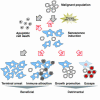Cellular senescence in cancer treatment: friend or foe?
- PMID: 14722606
- PMCID: PMC311442
- DOI: 10.1172/JCI20784
Cellular senescence in cancer treatment: friend or foe?
Abstract
Damage to DNA, the prime target of anticancer therapy, triggers programmed cellular responses. In addition to apoptosis, therapy-mediated premature senescence has been identified as another drug-responsive program that impacts the outcome of cancer therapy. Here, we discuss whether induction of senescence is a beneficial or, rather, a detrimental consequence of the therapeutic intervention.
Figures

References
-
- Schmitt CA, et al. A senescence program controlled by p53 and p16INK4a contributes to the outcome of cancer therapy. Cell. 2002;109:335–346. - PubMed
-
- te Poele RH, Okorokov AL, Jardine L, Cummings J, Joel SP. DNA damage is able to induce senescence in tumor cells in vitro and in vivo. Cancer Res. 2002;62:1876–1883. - PubMed
-
- Roninson IB, Broude EV, Chang BD. If not apoptosis, then what? Treatment-induced senescence and mitotic catastrophe in tumor cells. Drug Resist. Updat. 2001;4:303–313. - PubMed
-
- Robles SJ, Adami GR. Agents that cause DNA double strand breaks lead to p16INK4a enrichment and the premature senescence of normal fibroblasts. Oncogene. 1998;16:1113–1123. - PubMed
-
- Chang BD, et al. A senescence-like phenotype distinguishes tumor cells that undergo terminal proliferation arrest after exposure to anticancer agents. Cancer Res. 1999;59:3761–3767. - PubMed

